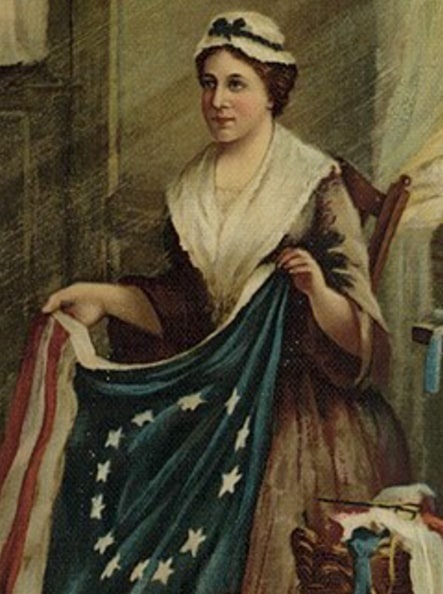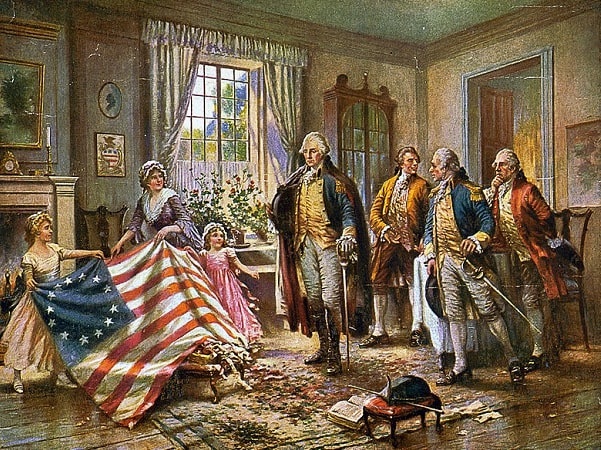Introduction: In this article – in honor of today being Flag Day – Jane Hampton Cook searches old newspapers to learn more about the apocryphal story of Betsy Ross and America’s first flag. Jane is a presidential historian and author of ten books, including Stories of Faith and Courage from the Revolutionary War. Her works can be found at Janecook.com. She is also the host of Red, White, Blue and You.
Every year Americans celebrate Flag Day on June 14 because that was the day in 1777 when the Continental Congress adopted the first flag, which is often called the Betsy Ross flag. As a result, it’s easy to assume that Congress mentioned Betsy Ross when they issued the first flag – but that is not the case, as revealed by historical newspaper articles.

The earliest newspaper account I could find of the first official U.S. flag was published by the Pennsylvania Evening Post on 30 August 1777, two and a half months after Congress made the decision to adopt the first flag.

This article reported from the minutes of the Continental Congress, which did not mention Betsy Ross:
“In CONGRESS, June 14, 1777. Resolved, That the FLAG of the United States be THIRTEEN STRIPES alternate red and white; that the union be THIRTEEN STARS white in a blue field, representing a new constellation.”
News of the new flag was noteworthy because its design differed significantly from the Grand Union flag, which George Washington and others had been using. Although the Grand Union flag featured alternating red and white stripes, it differed in one significant way: instead of a blue field with stars, it featured a small version of the British flag in the upper left-hand corner.
When General Washington flew the Grand Union flag in his effort to drive the British from Boston in March 1776, the British thought he was flying a British flag. This confusion exposed a need for a new distinctly American flag.
The connection of Betsy Ross to the first flag was not known to the wider American public for nearly 100 years – until her grandson told a story that many historians question.
The Portsmouth Journal of Literature and Politics reported in 1870:
This article, based on a presentation made by William J. Canby to the Pennsylvania Historical Society, reported:
“The first American flag, however, according to the design and approval of Congress, was made by Mrs. Elizabeth Ross. Three of her daughters still live in our vicinity to confirm this fact, founding their belief, not upon what they saw, for it was many years before they were born, but upon what their mother had often told them. A niece of this lady, Mrs. Margaret Boggs, aged ninety-five years, now lives in Germantown, and is conversant with the fact.”
Twice a widow, Betsy Ross later married John Claypoole and had five children. Canby was one of her grandsons.
Canby had told the story of how Betsy Ross became involved in making the first flag:
“It is related that when Congress had decided upon the design, Colonel George Ross and General Washington visited Mrs. Ross [the colonel’s widowed niece] and asked her to make it. She said, ‘I don’t know whether I can, but I’ll try,’ and directly suggested to the gentlemen that the design was wrong, in that the stars were six-cornered, and not five-cornered, as they should be.”
As an upholsterer, she knew the ins and outs of efficient cutting and sewing techniques for patterns such as stars.
Nearly 100 years after that, the Columbus Dispatch relayed more color to this family story through another family member.
This article reported about Betsy Ross’s great-granddaughter, Rachel Buehler, age 72:
“She heard the story from her grandmother, who was born and reared in the Philadelphia home of her own grandmother, Mrs. Elizabeth Claypoole – better known as Betsy Ross.”
Buehler expanded on the reason for a five-pointed star, noting that Ross “straightened out” George Washington.
“Washington wanted a flag, and he had a six-point star in mind. But Betsy said a five-pointed star would be more symmetrical. She showed them how she could fold a piece of paper and with one snip of the scissors make a perfect five-pointed star.”
Buehler also credited Ross with other features of the first flag.
“Betsy suggested they put the stars in a circle so no state would be ahead. Then the men suggested adding a new stripe for each new state. But she proposed instead to add a new star and keep the stripes for the original 13 states.”
And with that, a new constellation was born, stitched in history by Betsy Ross
Note: An online collection of newspapers, such as GenealogyBank’s Historical Newspaper Archives, is not only a great way to learn about the lives of your ancestors – the old newspaper articles also help you understand American history and the times your ancestors lived in, and the news they talked about and read in their local papers.
